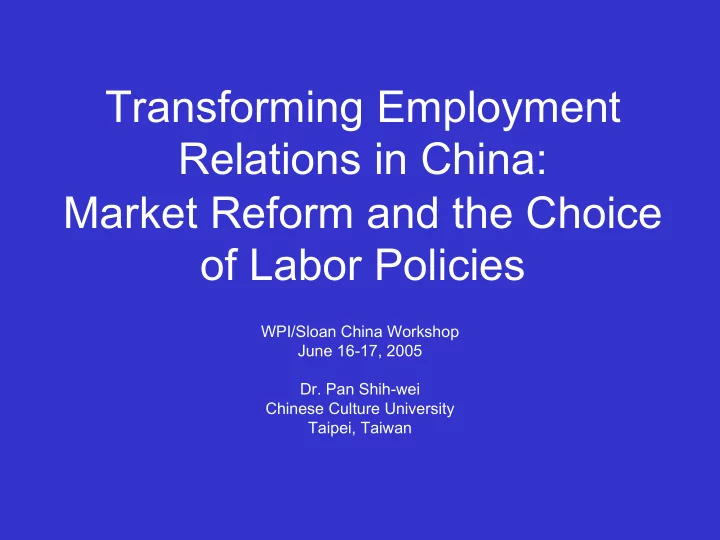

Transforming Employment Relations in China: Market Reform and the Choice of Labor Policies WPI/Sloan China Workshop June 16-17, 2005 Dr. Pan Shih-wei Chinese Culture University Taipei, Taiwan
The Analytical Framework • From state to market – state intervention – corporatist model – pluralistic model • Social and economic diversity – Regional & geographical differences – Different stages of economic development – Diverse racial & ethnic groups • Employment relations: What kind of relationships are developing between employers, labor and the state? • What are the available choices for labor policy?
Characteristics of China’s Employment Relations System • Tradeoff: Political stability vs. economic development • Employment relations system is a labor administration system • Monopolistic trade unionism (ACFTU) – CCP-directed workplace democracy – Government supervised collective bargaining • Dual structure of employment relations – State-owned enterprise – Private & foreign-owned enterprise
Transitions in the Employment Relations System • Traditional guarantees of employment, wages and welfare have eroded. • Enterprise instead of state now is responsible for economic management and financial solvency, as well as for employment relations. • Firms are experimenting with new management practices. • The mindset and institutions of state control remain embedded in the system.
Status of Employment Relations – Labor dispute as example • Contradictions between institutions and markets. – Legal & contractual regulation of labor relations. – Workplace consultation between employer and the trade union. • But institutional arrangement is diluted by the force of market competition. • Industrial disputes have increased as a result of this discrepancy.
Demographics Aspects of Industrial Disputes • Total number of disputes is increasing. – The number of workers involved increased from 77,794 in 1994 to 800,000 in 2003 • The number of collective disputes is increasing and exceeds the percentage of individual disputes. – More than 60% of disputes are collective – Money-related disputes: 50% – Labor protection disputes 14% – Labor contract disputes 25% • Arbitration settlement increased • Settlements increasingly favor labor’s demands. • More confrontation between labor and management
Labor’s Collective Incidents • Definition: Workers’ collective actions in support of demands they cannot achieve through legal channels. • Causes of collective incidents: – Money demands related restructuring and ownership reorganizing of state-owned firms – Mass layoffs by state-owned firms – Delays in wage payments – Payment of wages lower than standard wage – Poor working conditions in private & foreign firms – New employers that do not fulfill contractual obligations
Forms of Collective Action • Primitive mode: – Committee suicide, hunger strikes, detaining and killing the employer • Work stoppage and strike (wildcat) • Protest, rally, petition, sit-in, appeal to authorities • Floor jumping, stoppage of rail and highway transportation, bridge blockage • Firm protection action by employee assembly • Alliance and united strikes
Problems of China’s ER system • State-dominated trade union cannot represent workers’ interests – Multiple roles of the union leader – Obligation first to the state, then the firm, then to the worker – Leaders appointed by the party, not chosen from and among union members – Collective bargaining must fulfill the orders of the state, not respond to a voluntary labor-management process – A lack of real workers’ participation system in the restructuring process—complies with the CCP instruction • Institutional residual effects on modern concept of labor protection • Labor policy is subordinated to industrial policy • Different HR/ER strategy adopted by different firms produce different employment relations outcomes.
Conclusion • What are the choices of labor policy and institution? – Pluralistic model – Corporatist model • A balance between efficiency and equity • Can a “voice” model supplement the process and establish a stable balance?
Research Agenda • Comparative study of MNC ER strategy and practice • Regional ER regulations and its impact on ER • Sector-based study on ER strategy and practices • New forms of workplace ER practice and its impact on firm • ER and the impact on firm performance • Market-based initiatives on ER – Corporate social responsibility programs
Recommend
More recommend